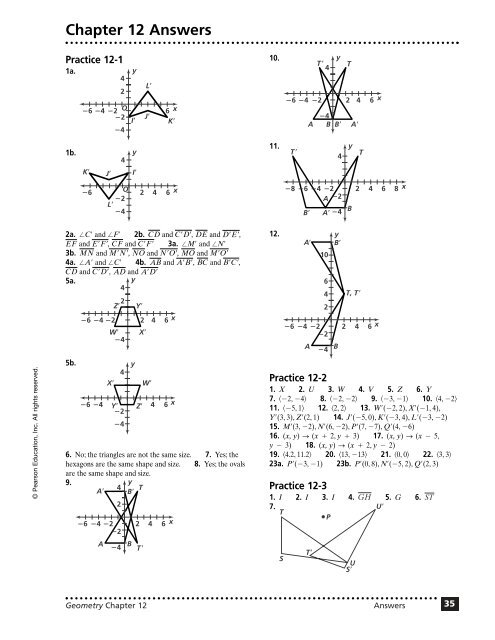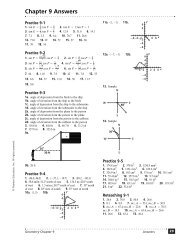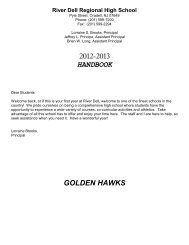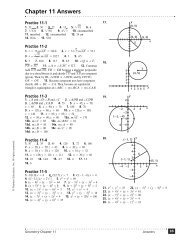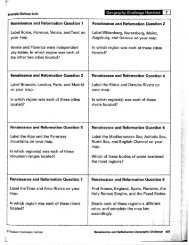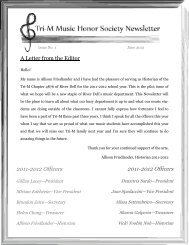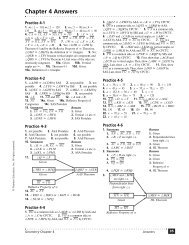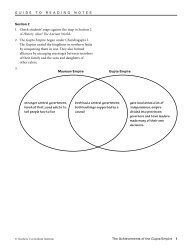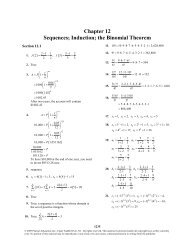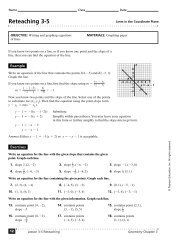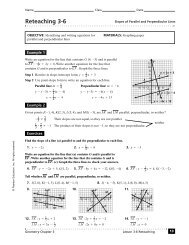Chapter 12 Answers (continued)
Chapter 12 Answers (continued)
Chapter 12 Answers (continued)
You also want an ePaper? Increase the reach of your titles
YUMPU automatically turns print PDFs into web optimized ePapers that Google loves.
<strong>Chapter</strong> <strong>12</strong> <strong>Answers</strong><br />
Practice <strong>12</strong>-1<br />
1a.<br />
y<br />
4<br />
L<br />
2<br />
6 4 2 O<br />
6 x<br />
2 J<br />
I K<br />
4<br />
10.<br />
T<br />
4<br />
6 4 2 2 4 6<br />
A<br />
y<br />
4<br />
B B<br />
T<br />
A<br />
x<br />
1b.<br />
4<br />
y<br />
11.<br />
T<br />
4<br />
y<br />
T<br />
K<br />
J<br />
I<br />
6<br />
O<br />
2 4 6<br />
2<br />
L<br />
4<br />
x<br />
8 6 4 2 2 4 6 8<br />
A 2<br />
B A 4<br />
B<br />
x<br />
© Pearson Education, Inc. All rights reserved.<br />
2a. C and F 2b. CD and CD, DE and DE,<br />
EF and EF, CF and CF 3a. M and N<br />
3b. MN and MN, NO and NO, MO and MO<br />
4a. A and C 4b. AB and AB, BC and BC,<br />
CD and CD, AD and AD<br />
5a.<br />
y<br />
4<br />
5b.<br />
6. No; the triangles are not the same size. 7. Yes; the<br />
hexagons are the same shape and size. 8. Yes; the ovals<br />
are the same shape and size.<br />
9.<br />
y<br />
A<br />
4 T<br />
B<br />
2<br />
6 4 2 2 4 6 x<br />
2<br />
A<br />
X<br />
2<br />
Z<br />
6 4 2 2 4 6<br />
W<br />
4<br />
4<br />
4<br />
6 4 Y 4 6 x<br />
Z<br />
2<br />
4<br />
B<br />
y<br />
Y<br />
X<br />
T<br />
W<br />
x<br />
<strong>12</strong>.<br />
Practice <strong>12</strong>-2<br />
1. X 2. U 3. W 4. V 5. Z 6. Y<br />
7. -2, -4 8. -2, -2 9. -3, -1 10. 4, -2<br />
11. -5, 1 <strong>12</strong>. 2, 2 13. W(-2, 2), X(-1, 4),<br />
Y(3, 3), Z(2, 1) 14. J(-5, 0), K(-3, 4), L(-3, -2)<br />
15. M(3, -2), N(6, -2), P(7, -7), Q(4, -6)<br />
16. (x, y) S (x + 2, y + 3) 17. (x, y) S (x - 5,<br />
y - 3) 18. (x, y) S (x + 2, y - 2)<br />
19. 4.2, 11.2 20. 13, -13 21. 0, 0 22. 3, 3<br />
23a. P(-3, -1) 23b. P(0, 8), N(-5, 2), Q(2, 3)<br />
Practice <strong>12</strong>-3<br />
1. I 2. I 3. I 4. GH 5. G 6. ST<br />
7.<br />
U<br />
T<br />
P<br />
S<br />
A<br />
T<br />
10<br />
6<br />
4<br />
2<br />
6 4 2 2 4 6 x<br />
2<br />
A<br />
4<br />
y<br />
B<br />
B<br />
T, T<br />
U<br />
S<br />
Geometry <strong>Chapter</strong> <strong>12</strong> <strong>Answers</strong> 35
C<br />
<strong>Chapter</strong> <strong>12</strong> <strong>Answers</strong> (<strong>continued</strong>)<br />
8.<br />
9.<br />
P<br />
O<br />
Practice <strong>12</strong>-4<br />
1. I. D II. C III. B IV. A 2. I. B II. A III. C IV. D<br />
3.<br />
B<br />
B<br />
B<br />
m<br />
N<br />
P<br />
P<br />
<br />
m<br />
Q<br />
O<br />
Q<br />
4.<br />
C<br />
N<br />
C<br />
10.<br />
O<br />
P<br />
N<br />
O<br />
m<br />
11. L<br />
<strong>12</strong>.<br />
13.<br />
O<br />
P'<br />
S<br />
S<br />
P'<br />
R<br />
N<br />
P M<br />
Q<br />
N<br />
R<br />
P<br />
P<br />
M<br />
O<br />
Q'<br />
P<br />
Q<br />
Q<br />
Q<br />
Q'<br />
R'<br />
R'<br />
Q<br />
L<br />
L<br />
L<br />
N<br />
M<br />
L<br />
L<br />
E<br />
M<br />
Q<br />
M<br />
Q<br />
P<br />
N<br />
P<br />
O<br />
5.<br />
6.<br />
7.<br />
8.<br />
S<br />
T<br />
B<br />
<br />
J<br />
4<br />
4<br />
2<br />
J<br />
y<br />
10<br />
y<br />
<br />
8<br />
6<br />
4<br />
E<br />
2<br />
S<br />
y<br />
E<br />
m<br />
J<br />
2 O 2 4 6 x<br />
2<br />
T<br />
E<br />
B<br />
S<br />
4 2 O 2 4 x<br />
m<br />
© Pearson Education, Inc. All rights reserved.<br />
2 O 2 4 6 8 x<br />
2<br />
T<br />
B<br />
4<br />
36<br />
<strong>Answers</strong> Geometry <strong>Chapter</strong> <strong>12</strong>
<strong>Chapter</strong> <strong>12</strong> <strong>Answers</strong> (<strong>continued</strong>)<br />
9.<br />
T<br />
y<br />
S<br />
5.<br />
4<br />
2<br />
E<br />
2 O 2 4 6<br />
B 2<br />
x<br />
6.<br />
10.<br />
y<br />
6<br />
B<br />
4<br />
4<br />
2<br />
2 O 2<br />
T <br />
4<br />
2<br />
E<br />
4<br />
S<br />
x<br />
7. This figure has no lines of symmetry.<br />
8.<br />
line symmetry and 72° rotational<br />
symmetry<br />
11.<br />
2<br />
y<br />
B<br />
9.<br />
6 E 2 O 4<br />
2<br />
4<br />
S<br />
T<br />
x<br />
10.<br />
line symmetry<br />
<strong>12</strong>.<br />
S<br />
4<br />
2<br />
y<br />
E<br />
line symmetry and 90° rotational<br />
symmetry<br />
© Pearson Education, Inc. All rights reserved.<br />
13.<br />
T<br />
B<br />
2 O 2 4 6 x<br />
2<br />
4<br />
4<br />
2<br />
4 2 O 2 4 6 x<br />
2<br />
4<br />
y<br />
E<br />
14. reflection 15. rotation 16. glide reflection<br />
17. translation<br />
B<br />
T <br />
S<br />
11.<br />
<strong>12</strong>.<br />
13.<br />
14.<br />
X<br />
O<br />
X<br />
line symmetry and 45° rotational<br />
symmetry<br />
180° rotational symmetry<br />
line symmetry<br />
Practice <strong>12</strong>-5<br />
1. The helmet has reflectional symmetry. 2. The teapot<br />
has reflectional symmetry. 3. The hat has both rotational<br />
and reflectional symmetry. 4. The hairbrush has<br />
reflectional symmetry.<br />
15.<br />
line symmetry and 45° rotational<br />
symmetry<br />
180° rotational symmetry<br />
Geometry <strong>Chapter</strong> <strong>12</strong> <strong>Answers</strong> 37
<strong>Chapter</strong> <strong>12</strong> <strong>Answers</strong> (<strong>continued</strong>)<br />
16.<br />
5.<br />
17. 18.<br />
line symmetry<br />
COOK<br />
6.<br />
line symmetry,<br />
rotational symmetry,<br />
translational symmetry,<br />
glide reflectional symmetry<br />
19. 20.<br />
21.<br />
H<br />
O<br />
A<br />
X<br />
7. 8.<br />
9.–11. Samples:<br />
9. 10.<br />
rotational symmetry,<br />
translational symmetry<br />
Practice <strong>12</strong>-6<br />
1.<br />
11.<br />
2.<br />
3.<br />
4.<br />
translational symmetry<br />
line symmetry,<br />
rotational symmetry,<br />
translational symmetry,<br />
glide reflectional symmetry<br />
translational symmetry<br />
<strong>12</strong>. yes 13. yes 14. no 15. yes 16. no<br />
17. no<br />
Practice <strong>12</strong>-7<br />
1. L(-2, -2), M(-1, 0), N(2, -1), O(0, -1)<br />
2. L(-30, -30), M(-15, 0), N(30, -15), O(0, -15)<br />
3. L(-<strong>12</strong>, -<strong>12</strong>), M(-6, 0), N(<strong>12</strong>, -6), O(0, -6)<br />
5 1<br />
4. 3<br />
5.<br />
2<br />
6. 2 7. yes 8. no 9. no<br />
10. R<br />
R<br />
11.<br />
A<br />
A<br />
O<br />
T<br />
T<br />
R<br />
R<br />
© Pearson Education, Inc. All rights reserved.<br />
line symmetry,<br />
rotational symmetry,<br />
translational symmetry,<br />
glide reflectional symmetry<br />
A<br />
A<br />
T<br />
38<br />
<strong>Answers</strong> Geometry <strong>Chapter</strong> <strong>12</strong>
<strong>Chapter</strong> <strong>12</strong> <strong>Answers</strong> (<strong>continued</strong>)<br />
<strong>12</strong>.<br />
R<br />
8.<br />
Z<br />
R<br />
Y<br />
O<br />
X<br />
A<br />
T<br />
X<br />
Z<br />
A<br />
T<br />
1 1<br />
13. P(-<strong>12</strong>, -<strong>12</strong>), Q(-6, 0), R(0, -6) 14. P(- 2, 4 ),<br />
1 1 3<br />
Q(1 4<br />
,-<br />
4), R(1 4,2) 15. P(-21, 6), Q(3, 24),<br />
R(-6, 6) 16. P(-2, 1), Q(-1, 0), R(0, 1)<br />
Reteaching <strong>12</strong>-1<br />
1.–5. Check students’ work. 6. reflection over x-axis:<br />
F(-1, -3), G(-5, -1), H(-3, -5); reflection over y-axis:<br />
F(1, 3), G(5, 1), H(3, 5) 7. reflection over x-axis:<br />
C(2, -4), D(5, -2), E(6, -3); reflection over y-axis:<br />
C(-2, 4), D(-5, 2), E(-6, 3) 8. reflection over x-axis:<br />
J(-1, 5), K(-2, 3), L(-4, 6); reflection over y-axis:<br />
J(1, -5), K(2, -3), L(4, -6)<br />
Reteaching <strong>12</strong>-2<br />
1.–5. Check students’ work. 6. A(0, -3), B(1, 1),<br />
C(4, -1), D(5, -4) 7. A(4, -2), B(5, 2), C(8, 0),<br />
D(9, -3) 8. A(3, 5), B(4, 9), C(7, 7), D(8, 4)<br />
Reteaching <strong>12</strong>-4<br />
1. translation 2. reflection 3. rotation<br />
4. glide reflection 5. rotation 6. glide reflection<br />
7. reflection 8. translation<br />
Reteaching <strong>12</strong>-5<br />
1. two lines of symmetry (vertical and horizontal), 180°<br />
rotational symmetry (point symmetry) 2. one line of<br />
symmetry (horizontal) 3. one line of symmetry (vertical)<br />
4. two lines of symmetry (vertical and horizontal), 180°<br />
rotational symmetry (point symmetry) 5. one line of<br />
symmetry (vertical) 6. one line of symmetry (vertical)<br />
Reteaching <strong>12</strong>-6<br />
1.<br />
© Pearson Education, Inc. All rights reserved.<br />
Reteaching <strong>12</strong>-3<br />
1.–5.<br />
6.<br />
Y<br />
Y<br />
7. Sample:<br />
Y<br />
Z<br />
Z<br />
X<br />
X<br />
Z<br />
X<br />
T<br />
X<br />
T<br />
Y<br />
Y<br />
Z<br />
Z<br />
2. Sample:<br />
3.<br />
4.<br />
line symmetry in the dashed lines,<br />
rotational symmetry around points,<br />
translational symmetry,<br />
glide reflectional symmetry<br />
line symmetry in the dashed lines,<br />
rotational symmetry around points,<br />
translational symmetry,<br />
glide reflectional symmetry<br />
Y<br />
X<br />
S<br />
Z<br />
X<br />
rotational symmetry around<br />
points, translational symmetry<br />
Geometry <strong>Chapter</strong> <strong>12</strong> <strong>Answers</strong> 39
<strong>Chapter</strong> <strong>12</strong> <strong>Answers</strong> (<strong>continued</strong>)<br />
5.<br />
Reteaching <strong>12</strong>-7<br />
1. Check students’ work.<br />
2.<br />
4<br />
y<br />
2<br />
4 2 O<br />
2<br />
2 4<br />
x<br />
line symmetry in the dashed<br />
lines, rotational symmetry<br />
around points, translational<br />
symmetry, glide reflectional<br />
symmetry<br />
5.<br />
1<br />
2<br />
6. y =<br />
1<br />
x + 2<br />
6<br />
K<br />
4<br />
2<br />
J<br />
6 4 2 0<br />
2<br />
J'<br />
4<br />
6<br />
7.<br />
4<br />
y<br />
L<br />
L'<br />
2 4 6 x<br />
K'<br />
y<br />
4<br />
T'<br />
2<br />
3.<br />
4.<br />
4<br />
2<br />
y<br />
4 O 2 4<br />
2<br />
4<br />
x<br />
4<br />
y<br />
6 4 2 0<br />
Q'<br />
2<br />
Q<br />
T<br />
y =-4<br />
8.<br />
4<br />
6<br />
8<br />
6<br />
y<br />
R'<br />
R<br />
2 S' 4 6x<br />
S<br />
E'<br />
5.<br />
<strong>12</strong><br />
10<br />
6<br />
4<br />
2<br />
86<br />
2 2 4 6 8 x<br />
4<br />
6<br />
8<br />
10<br />
<strong>12</strong><br />
y<br />
2<br />
<strong>12</strong> 8 6 4 2 O 2 4 6 8 <strong>12</strong>x<br />
2<br />
4<br />
y =-x<br />
9.<br />
D<br />
6<br />
4<br />
2<br />
6 4 0<br />
B<br />
2<br />
C<br />
D<br />
D'<br />
A<br />
4<br />
2<br />
6 4 2 0<br />
2<br />
F<br />
E<br />
4<br />
6<br />
4<br />
y<br />
F'<br />
2 4 6x<br />
A'<br />
2 6<br />
B'<br />
C'<br />
D'<br />
x<br />
© Pearson Education, Inc. All rights reserved.<br />
Enrichment <strong>12</strong>-1<br />
1. (-3, -1) 2. (-1, 0) 3. (5, 3)<br />
x 1<br />
1 x 2<br />
y 1<br />
1 y 2<br />
4. the midpoint formula: M = ( , )<br />
2<br />
2<br />
6<br />
x = 1<br />
40 <strong>Answers</strong> Geometry <strong>Chapter</strong> <strong>12</strong>
<strong>Chapter</strong> <strong>12</strong> <strong>Answers</strong> (<strong>continued</strong>)<br />
10.<br />
M'<br />
6<br />
M<br />
y<br />
N<br />
Enrichment <strong>12</strong>-4<br />
1.–9. Check students’ work. 10. <strong>12</strong>-3; rotation; twice<br />
11. 130 <strong>12</strong>. 100 13. 160<br />
2<br />
8 6 4 2 0<br />
N'<br />
2<br />
Q'<br />
4<br />
P'<br />
6<br />
y =-2x - 2<br />
11.<br />
U'<br />
6<br />
V'<br />
4<br />
2<br />
W' T'<br />
8 6 4 2 0<br />
2<br />
4<br />
6<br />
Q<br />
y<br />
T<br />
P<br />
4 6x<br />
U<br />
V<br />
4 6x<br />
W<br />
Enrichment <strong>12</strong>-5<br />
1. yes; rotational and point symmetry 2. no 3. yes;<br />
rotational and point symmetry 4. yes; rotational and point<br />
symmetry 5. no 6. no 7. diamonds 8. <strong>12</strong><br />
9. Seven of diamonds; this does not have symmetry because<br />
the diamond in the middle is toward either the bottom or top<br />
of the card, and when you rotate the card 180°, the position<br />
will be reversed. 10. All the face cards have symmetry.<br />
11. yes; 2, 4, 10 <strong>12</strong>. No; Sample: When you look at the<br />
card one way, three of the points of the hearts are pointing<br />
down, and five are pointing up. When you rotate the card 180º,<br />
five of the points of the hearts are pointing down, and three<br />
are pointing up. 13. No; because the number and suit of<br />
each card are placed in opposite corners, none of the cards<br />
have line symmetry. 14. You can add a backward 3 with<br />
the small club below it to the two empty corners to create line<br />
symmetry, or you can remove the 3 with the small club below<br />
it from each of the two corners.<br />
Enrichment <strong>12</strong>-6<br />
y = 3x + 2<br />
<strong>12</strong>.<br />
G'<br />
6<br />
4<br />
y<br />
© Pearson Education, Inc. All rights reserved.<br />
1<br />
y =-x 2 - 1<br />
H'<br />
2<br />
8 6 4 2 0<br />
H<br />
2<br />
G<br />
4<br />
I<br />
6<br />
K'<br />
2 J' 4 6x<br />
Enrichment <strong>12</strong>-2<br />
1. -7, -2 2. 4, -7 3. -10, 5 4. -3, -9<br />
5. Foster 6. yes 7. Wilson 8. -7, -3 9. C<br />
I'<br />
J<br />
K<br />
Enrichment <strong>12</strong>-3<br />
1. (0, -2, 3) 2. (-2, -2, 3) 3. (-2, -2, 0)<br />
4. (0, -2, 0) 5. (0, -6, 0) 6. (0, -6, 3)<br />
7. (-2, -6, 3) 8. (-2, -6, 0) 9. (2, 0, 3)<br />
10. (2, -2, 3) 11. (2, -2, 0) <strong>12</strong>. (2, 0, 0)<br />
13. (6, 0, 0) 14. (6, 0, 3) 15. (6, -2, 3)<br />
16. (6, -2, 0)<br />
Enrichment <strong>12</strong>-7<br />
1a. (2, 0, 2) 1b. (0, 0, 2) 1c. (0, 2, 2) 1d. (2, 2, 2)<br />
1e. (2, 0, 0) 1f. (0, 0, 0) 1g. (0, 2, 0) 1h. (2, 2, 0)<br />
2a. (4, 0, 4) 2b. (0, 0, 4) 2c. (0, 4, 4) 2d. (4, 4, 4)<br />
2e. (4, 0, 0) 2f. (0, 0, 0) 2g. (0, 4, 0) 2h. (4, 4, 0)<br />
3. (0, 0, 0) 4. 2 5. Each edge in the image is double<br />
that in the preimage. 6. Samples: Three faces are<br />
coplanar for image and preimage; three faces are parallel;<br />
Geometry <strong>Chapter</strong> <strong>12</strong> <strong>Answers</strong> 41
<strong>Chapter</strong> <strong>12</strong> <strong>Answers</strong> (<strong>continued</strong>)<br />
each face in the image has two times the perimeter and four<br />
times the area of the corresponding face in the preimage.<br />
7. Surface area of image = 96 sq. units; surface area of<br />
preimage = 24 sq. units; the ratio of the surface areas is<br />
4 : 1. 8. Volume of image = 64 cubic units; volume of<br />
preimage = 8 cubic units; the ratio of the volumes is 8 : 1.<br />
9. Dilations in three dimensions are proportional to dilations<br />
in two dimensions.<br />
<strong>Chapter</strong> Project<br />
Activity 1: Investigating<br />
a. vertical<br />
b. vertical<br />
c. both<br />
Activity 2: Modeling<br />
a. Ancient Egyptian ornament<br />
✔ Checkpoint Quiz 2<br />
1. line symmetry;<br />
rotational; 180°<br />
2. line symmetry;<br />
rotational; 180°<br />
3. line symmetry<br />
H<br />
b. Oriental design<br />
c. Greek vase design<br />
Activity 3: Investigating<br />
a, b<br />
Activity 4: Classifying<br />
a. mg<br />
b. <strong>12</strong><br />
Activity 5: Creating<br />
Check students’ work.<br />
✔ Checkpoint Quiz 1<br />
1. No; the figures are not the same size. 2. yes<br />
3. yes 4. –3, –2 5. 6 units right and 4 units down<br />
6. a resultant translation of 4 units right and 11 units up<br />
7. C<br />
8. D'<br />
L<br />
C'<br />
B'<br />
L' A B'<br />
B D<br />
B<br />
C<br />
C'<br />
A, A'<br />
9.<br />
C<br />
C'<br />
A<br />
D D'<br />
10. T( 8, -5), Q(2, -3) and R(4, 0)<br />
4. rotational; 180° 5. translational; no turns<br />
6. rotational; preimage turns 7. translational<br />
8. rotational, reflectional, translational 9. translational<br />
<strong>Chapter</strong> Test, Form A<br />
1. P(13, 0), Q(10, -2), R(11, -4), S(13, -6)<br />
2. P(-1, -2), Q(2, -4), R(1, -6), S(-1, -8)<br />
3. P(0, -5), Q(2, -2), R(4, -3), S(6, -5)<br />
4. P(-2.5, 0), Q(-1, -1), R(-1.5, -2), S(-2.5, -3)<br />
5. P(5, 2), Q(2, 0), R(3, -2), S(5, -4) 6. P(-11, 3),<br />
Q(-8, 1), R(-9, -1), S(-11, -3) 7. glide reflection<br />
8. translation 9. translation 10. rotation<br />
11.<br />
<strong>12</strong>. line symmetry 13. rotational symmetry<br />
14a. Any two of the following: ABCDEHIKMOTUVWXY<br />
14b. Any two of the following: HINOSXZ<br />
15. Translations can be performed on the pieces because they<br />
can slide. Rotations can be performed on the pieces because<br />
each piece can be turned. Reflections and glide reflections<br />
cannot be performed on the pieces because the back of a<br />
puzzle piece is useless in solving the puzzle. Dilations are<br />
impossible because the pieces cannot change size.<br />
16. A 17. Sample: glide reflectional, rotational, line,<br />
and translational<br />
1 3<br />
18. L(-3, 6), M(6, 6), N(3, -9) 19. L( 2 , - 4 ),<br />
3 5 1<br />
M( 4 ,1), N( 4, - 2) 20. L(-18, -18), M(-18, 18),<br />
5 7<br />
N(0, 0) 21. L(3, -2), M(0, - 3 ), N( 3, -2)<br />
© Pearson Education, Inc. All rights reserved.<br />
42<br />
<strong>Answers</strong> Geometry <strong>Chapter</strong> <strong>12</strong>
<strong>Chapter</strong> <strong>12</strong> <strong>Answers</strong> (<strong>continued</strong>)<br />
3<br />
22. YZ = 15 cm; XZ = 24 cm; scale factor = 7<br />
5<br />
23. XY = 25 in.; YZ = 40 in.; scale factor = 3<br />
24. (-1, 3) 25. (5, 4) 26. (-2, -7) 27. (2, -7)<br />
28. (1, -1) 29. (-3, 1)<br />
<strong>Chapter</strong> Test, Form B<br />
1. W(-6, -1), X(-4, -4), Y(0, -3), Z(-2, 0)<br />
2. W(-5, 0), X(-3, 3), Y(1, 2), Z(-1, -1)<br />
3. W(3, 6), X(6, 4), Y(5, 0), Z(2, 2) 4. W(-2, 1),<br />
4 5 2 2<br />
X(- 3,2), Y(0, 3), Z(- 3, 3) 5. W(-3, -3),<br />
X(-1, -6), Y(3, -5), Z(1, -2) 6. W(-9, 1),<br />
X(-7, 4), Y(-3, 3), Z(-5, 0) 7. glide reflection<br />
8. translation 9. translation 10. rotation<br />
11.<br />
<strong>12</strong>. no symmetry 13. line symmetry 14a. Any two<br />
of the following: ABCDEHIKMOTUVWXY 14b. Any<br />
two of the following: HINOSXZ 15. Reflections and glide<br />
reflections cannot be performed on the pieces because the<br />
back of a puzzle piece is useless in solving the puzzle. Dilations<br />
are impossible because the pieces cannot change size. Translations<br />
can be performed on the pieces because they can slide.<br />
Rotations can be performed on the pieces because each piece<br />
can be turned. 16. B 17. Sample: glide reflectional,<br />
rotational, line, and translational<br />
TASK 2: Scoring Guide<br />
Sample:<br />
3 Student draws a figure that accurately reflects the stated<br />
conditions.<br />
2 Student draws a figure that is mostly correct but falls just<br />
short of satisfying all the stated conditions.<br />
1 Student draws a figure that has significant flaws relative to<br />
the stated conditions.<br />
0 Student makes little or no effort.<br />
TASK 3: Scoring Guide<br />
Sample:<br />
The car can undergo translations and rotations as it moves<br />
and turns. But it can undergo neither a dilation, which would<br />
change its size, nor a reflection, which would, for example,<br />
put the steering wheel on the passenger side.<br />
3 Student gives a correct and thorough explanation.<br />
2 Student gives an explanation that demonstrates<br />
understanding of transformations but may contain minor<br />
errors or omissions.<br />
1 Student gives an explanation containing major errors or<br />
omissions.<br />
0 Student makes little or no effort.<br />
TASK 4: Scoring Guide<br />
Sample:<br />
4<br />
y<br />
© Pearson Education, Inc. All rights reserved.<br />
1 5 1<br />
18. S(- 4,1), T(1, 4 ), U(0, 2) 19. S(0, 0),<br />
T(20, -8), U(<strong>12</strong>, -20) 20. S(-20, -15), T(-20, 5),<br />
5 1<br />
U(-10, -10) 21. S(- 2,4), T(- 2, -1), U(-3, -4)<br />
3<br />
22. YZ = 63 cm; XZ = 39 cm; scale factor = 2<br />
3<br />
23. XY = 21 ft; XZ = <strong>12</strong> ft; scale factor = 4<br />
24. (-5, 2) 25. (7, 3) 26. (-1, -2) 27. (4, -1)<br />
28. (3, -8) 29. (-4, 0)<br />
Alternative Assessment, Form C<br />
TASK 1: Scoring Guide<br />
20; 200 cm; all distances are magnified 20 times.<br />
3 Student gives correct answers and a clear and accurate<br />
explanation.<br />
2 Student gives answers and an explanation that are largely<br />
correct.<br />
1 Student gives answers or an explanation that may contain<br />
serious errors.<br />
0 Student makes little or no effort.<br />
4<br />
a. translation:<br />
4<br />
2<br />
4<br />
2<br />
4<br />
2<br />
4<br />
b. dilation:<br />
4<br />
2<br />
y<br />
y<br />
2 2<br />
2<br />
4 x<br />
2 4x<br />
x<br />
translation vector: 1, 0<br />
scale factor: 2<br />
Geometry <strong>Chapter</strong> <strong>12</strong> <strong>Answers</strong> 43
<strong>Chapter</strong> <strong>12</strong> <strong>Answers</strong> (<strong>continued</strong>)<br />
c. reflection:<br />
y<br />
2<br />
4 2<br />
2<br />
4<br />
d. glide reflection:<br />
e. rotation:<br />
4 2<br />
4<br />
2<br />
4 2<br />
2<br />
4<br />
4<br />
2<br />
y<br />
y<br />
2<br />
4 x<br />
4 x<br />
4 x<br />
line of reflection: y = 1<br />
The glide reflection is equivalent to<br />
a translation 2, 0 followed by a<br />
reflection in the line y =-2.<br />
degrees of rotation: 90<br />
19.<br />
20. Equilateral triangle, square, and regular hexagon;<br />
the measure of each interior angle is a factor of 360.<br />
21. If a triangle is not a right triangle, then the Pythagorean<br />
Theorem cannot be applied.<br />
22.<br />
y<br />
4<br />
V<br />
2<br />
V<br />
U U<br />
4 2 4 6 x<br />
W<br />
2<br />
W<br />
4<br />
23. 21.21<br />
T<br />
4<br />
2<br />
T<br />
4 2 4 x<br />
U G<br />
2<br />
y<br />
U<br />
G<br />
4<br />
3 Student gives accurate graphs and correctly identifies the<br />
details the problem calls for.<br />
2 Student gives generally correct graphs and details, although<br />
the work may contain some errors.<br />
1 Student gives graphs and accompanying details that contain<br />
significant errors or omissions.<br />
0 Student makes little or no effort.<br />
Cumulative Review<br />
1. D 2. B 3. B 4. C 5. A 6. D 7. B<br />
8. C 9. C 10. D 11. B <strong>12</strong>. C 13. A<br />
14. D 15. B 16. 49 cm 3 17. A, H, I, M, O, T, U, V,<br />
W, X, Y 18. Rotational; it is turning around a fixed point,<br />
the corner.<br />
© Pearson Education, Inc. All rights reserved.<br />
44<br />
<strong>Answers</strong> Geometry <strong>Chapter</strong> <strong>12</strong>


